
Prunella Gee in the 1977 stage adaption of Illuminatus!
Send us your Eris of the Month Club submissions (more info here) by using the form at the bottom of The MGT. page.

Send us your Eris of the Month Club submissions (more info here) by using the form at the bottom of The MGT. page.

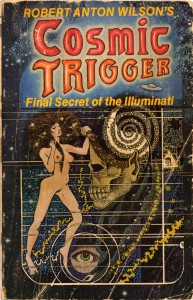
I believe it was through Cosmic Trigger that I became aware of James Shelby Downard (maybe), although Downard might have first popped up on my radar via Adam Parfrey’s seminal anthology Apocalypse Culture (1987), which I probably read around the same time I first sunk my teeth into Cosmic Trigger in the late 1980s, and which did a similar number to my head.
During the period RAW was experiencing all of his Sirius synchronicities, a Fortean researcher named William Grimstad sent him an audio cassette series entitled Sirius Rising, a recording with James Shelby Downing that “…set forth the most absurd, the most incredible, the most ridiculous Illuminati theory of them all…[that] the Illuminati were preparing Earth, in an occult manner, for extraterrestrial contact…. The only trouble is that, after the weird data we have already surveyed [in Cosmic Trigger], the Grimstad-Downard theory may not sound totally unbelievable to us….”
At the time, Downard was an obscure and little known figure outside the small circle of Fortean/Conspiracy researchers who gravitated around him that included Bill Grimstad, Michael Anthony Hoffman II and Charles Saunders.
Due in some measure to Downard’s influence, Grimstad (under the non-de-plume of Jim Brandon) authored the Fortean classics Weird America (1978) and The Rebirth of Pan (1983). In the “Dallas, Texas” section of Weird America, Brandon presented the theory that JFK was a “ceremonial king-who-must-die” killed by modern age alchemists following an ancient druidic tradition, a hypothesis arrived at by a “certain body of opinion, undoubtedly the farthest out brain wave of assassinology yet.” No direct mention was made, at this time, as to the theory’s originator: James Shelby Downard.
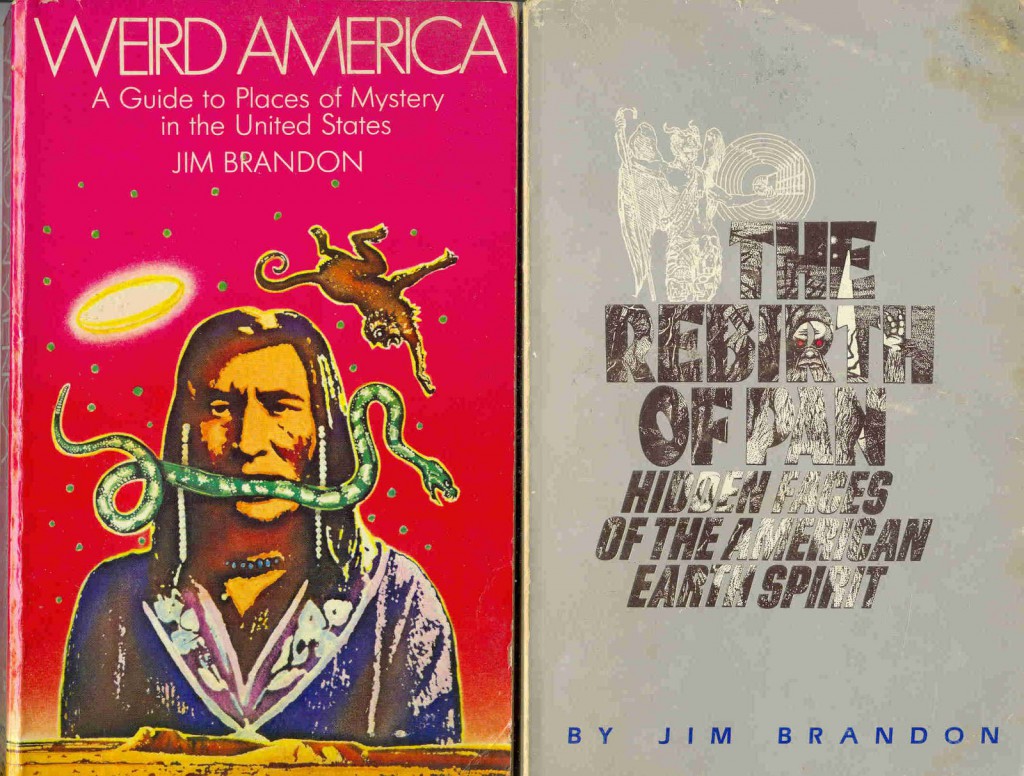
It was through “King Kill 33°: Masonic Symbolism in the Assassination of John F. Kennedy” (featured in Apocalypse Culture) that Downard first came to the attention of conspiratologists and over time rose to the status of a mythic figure who traveled across the country in his famous airstream trailer investigating Fortean mysteries and battling Freemasonic adversaries at every turn, his trusty Colt 45 always at his side.

As for unpublished works, Michael Hoffman informed me several years ago that Downard’s “…niece, Robbie Smith, had in her possession at his death, Mr. Downard’s locked suitcase files which neither Mr. Grimstad, this writer or Charles Saunders had ever seen. She told me about some of the contents. I was desperate to buy them but could not meet her price. She admitted to destroying some of his materials after his death! I found her difficult. God willing, she has preserved something and someone will be able to purchase these from her one day. If it’s all lost, it’s a tragedy.”
This news that the last remnants of Downard’s literary legacy might have knowingly or unknowingly been tossed into a dumpster was certainly a disappointing prospect, which is what would have happened to the Discordian Archives had not Dr. Bob Newport intervened and rescued them from Greyfaced oblivion.
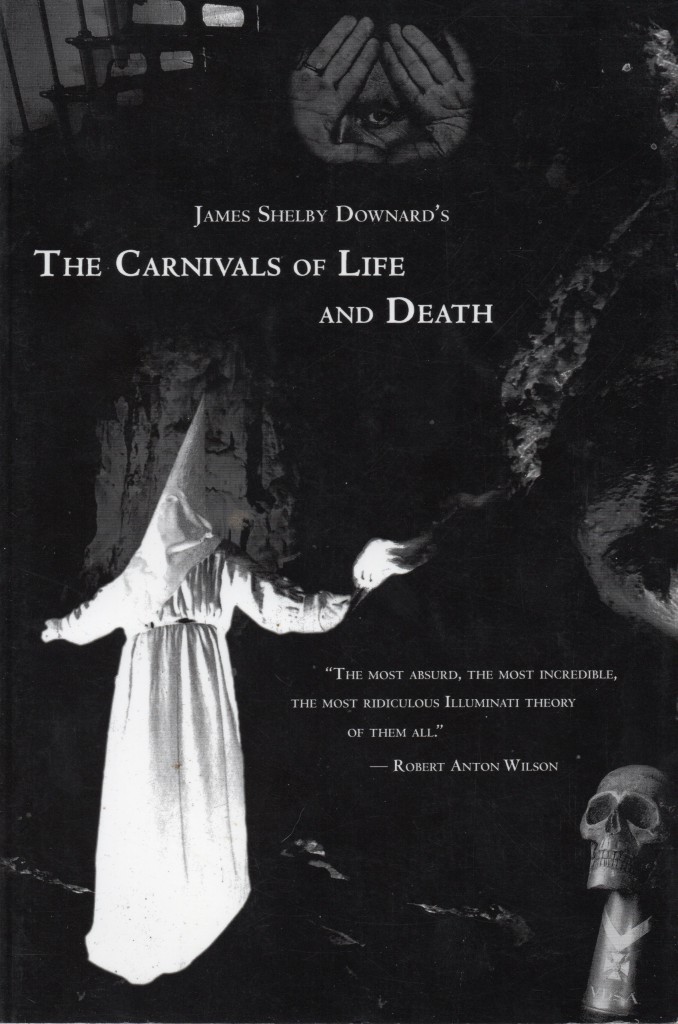
In the intro to The Carnivals of Life and Death, Adam Parfrey noted that Downard died before he could write the second part of his biography and so the general consensus seemed to be that we’d probably never see any further Downardian writings—that is, until NOW…
During the course of writing James Shelby Downard’s Mystical War, I corresponded not only with Michael Hoffman, but also Bill Grimstad, and stayed in touch with Bill over the last decade. At the end of 2015, Grimstad informed me that he’d come into possession of what appeared to be Part 2 of Downard’s biography(!) and inquired if I was interested in publishing the material. Hell, yes, I responded.
The caveat, though, was that the manuscript was in microfiche format (circa 1980s) and would need to be converted into tiffs. I agreed to split the costs for this process, and then afterwards began sorting through the material, which in itself proved a somewhat daunting task due to the fact that it consisted of a staggering 799 pages, a combination of biographical material as well as Downard hashing out his central themes and theories in a manner that only he could do.

Phase two of the project entailed converting the manuscript to PDF and getting it into proper chronological order, but this as well was somewhat challenging and was making my head hurt a bit; it seemed the only way to review it and make sure I had all the pages in correct order was to print out the beast, maybe a few pages at a time. After printing out a dozen or so pages, I realized that about 2/3rds of my black ink cartridge had been sucked dry due to the black margins on the pages that were a by-product of the microfiche conversion. A visit to FedEx-Kinko’s and $150 later, I had a printed version in my hot little hands, which was a lot less expensive than sinking several hundred dollars into black ink cartridges. (Yes, I realize this is a first world problem!)
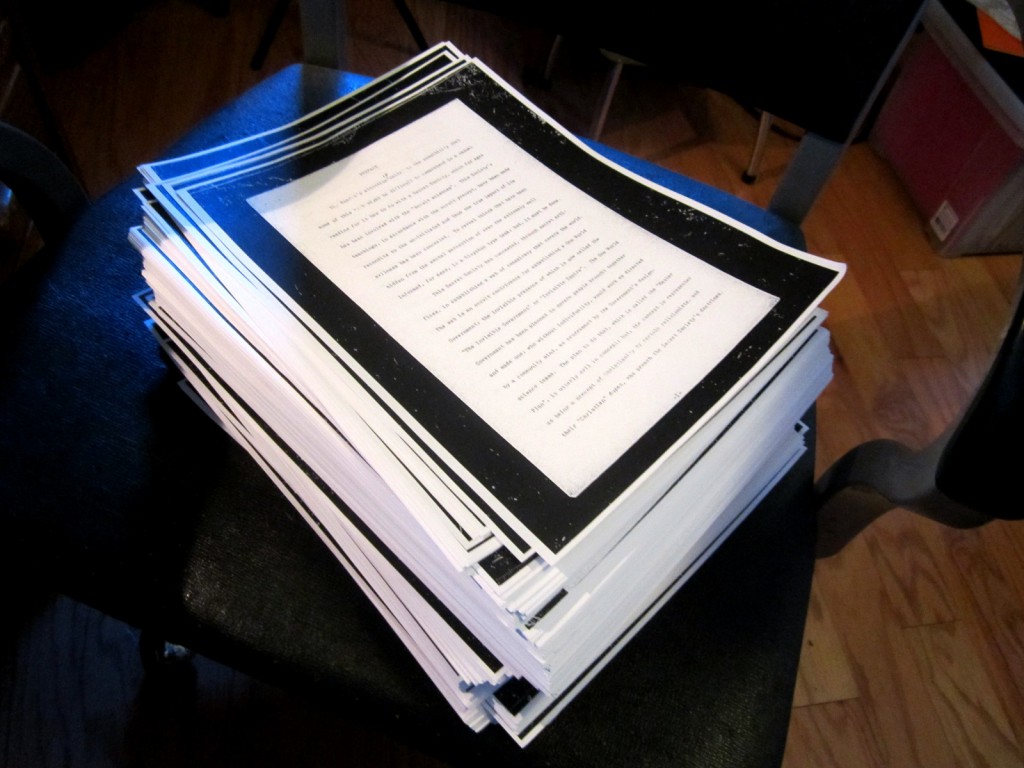
The plan from there was to OCR the beast and just edit as I go. Unfortunately, the first test OCR revealed that each page would take more time correcting the OCR errors than it would take to just retype the whole enchilada fresh—which is exactly what I’m doing now, a few pages here and a few pages there—in between other projects I’m currently working on.
If there are any volunteers out there who would like to assist me in the typing drudgery, say 50 pages at a pop, drop me a line and this will allow you a sneak peak at a portion of Downard’s missing magnum opus—not to mention a gratis copy after it’s published!
To be continued…
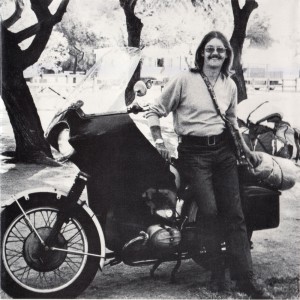
Born Roger Watlington in Knoxville, Tennessee on May 11, 1941, he later changed his name to Roger Lovin which would prove apropos in terms of the footloose and fancy free lifestyle he later adopted.
In the early 1960s, Lovin managed a French Quarter coffee house called The Gryphon, which doubled as a bohemian art gallery and hangout for French Quarter beatniks. In this regard, a curious news article appeared in the Oct 12, 1964 The Times-Picayune about a smoke bomb attack at The Gryphon that caused minor damage and one injury.
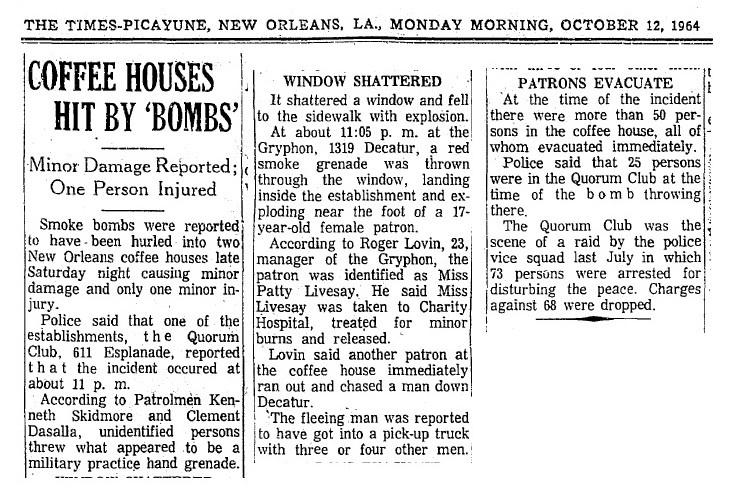
It’s unknown if the bombing was in any way directed at Lovin, although that wouldn’t come as a surprise as he was always a somewhat controversial character fond of ruffling the feathers of the squares. However, I suspect this incident may have had something to do with the bohemian clientele that frequented The Gryphon and a certain conservative element in New Orleans that was probably none too thrilled about it. As noted in the news article, a similar smoke bomb attack went down at the Quorum Coffee House (also known as The Quorum Club), another establishment with deep Discordian ties. A Wikipedia entry describes The Quorum as “a coffee house in New Orleans, known as a model for multicultural exchanges in the politically and racially charged atmosphere of the 1960s. It became a frequent target of segregationist harassment in New Orleans after it opened to persons from all racial backgrounds in 1963. In 1964, police raided The Quorum and arrested 73 people on charges such as ‘playing guitars out of tune.’”
Although The Quorum was a multicultural beatnik mecca, Kerry Thornley returned to New Orleans in the summer of 1964 and delivered a decidedly un-beatnik type lecture there on Ayn Rand and Objectivism—but that was typical Thornley: an iconoclast who reveled in tweaking people’s sensibilities on either side of the cultural or political spectrum. It’s also important to note that Kerry’s last meeting with the notorious Gary Kirstein (aka Brother-in-law who supposedly lured him into the JFK assassination) took place on the back patio of The Quorum (cast in creepy shadows) following Kerry’s lecture there that night.
Another Early Discordian, Barbara Reid (the main witness against Kerry in the Jim Garrison fiasco), became known as a “den mother” to a group of hippie kids that hung out at The Quorum, so the Discordian connections ran deep and weird. Apparently, there’s a film documentary about The Quorum called, appropriately enough (yes, you guessed it), The Quorum, which speaks to the influence this coffee house had on French Quarter culture. The website for The Quorum film describes how it was started in 1963 “by an idealistic group of individuals most of whom had met at the Ryder, an earlier, short-lived, racially integrated coffee house on Rampart Street in the New Orleans French Quarter. When the Ryder was shut down by city officials on the pretext of needing the space to construct a hotel, approximately twelve of the former Ryder patrons banded together to establish a similar sort of establishment with a similar purpose….”
As it so happens, the defunct Ryder coffee house (mentioned above) became of interest to Jim Garrison during his JFK assassination investigation as a supposed meeting place where Thornley had met with Lee Harvey Oswald and other suspected diabolical doings went down, which I previously covered in this post. But I digress…
The Quorum and Gryphon smoke bombings occurred during the same period Jim Garrison rolled out a campaign to “clean up” the French Quarter, and the specific targets of this campaign were strip clubs and establishments catering to the homosexual community. This is not to suggest that Garrison was in any way responsible for the smoke bomb caper, but what these events spoke to was the tension and unrest brewing across the cultural landscape, particularly in the French Quarter which had always been a fertile breeding ground for freaks and free spirits to flourish.
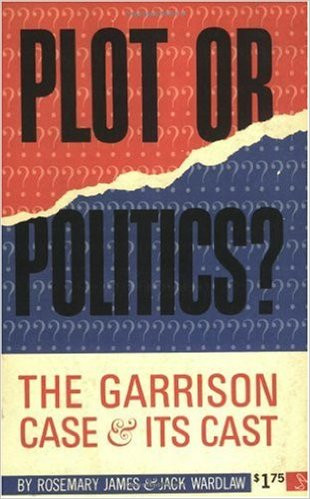
In regards to Garrison’s campaign against “vice,” pages 21 and 22 of Plot Or Politics? informs the reader that:
Almost as soon as he took office, Garrison took aim at the city’s sin strip—“The Street”, Bourbon Street. Former New Orleans newsman Bill Stuckey recalls:
“Shortly after he became district attorney in 1962, [Garrison] launched a crackdown on homosexuals in New Orleans, raiding ‘gay bars’ frequently, arresting ‘gay kids’ on the streets of the French Quarter. After one such arrest, the New Orleans States-Item sent me to the police station to see what the formal charges were. There, on paper, probably was one of the strangest charges in U.S. legal history: ‘Being a homosexual in an establishment with a liquor license.’ The drive died down after several weeks. One benefit of it may have been the creation of a body of homosexual informants for the district attorney’s office—informants possibly involved in his Kennedy plot investigation.”
It probably appears like I’m once again digressing, but I wanted to lay out the cultural landscape of the period—a culture in which Lovin was knee deep—and the conditions that precipitated the crackdown on the homosexual community, all of which might have attributed to the coffee house smoke bombings, and a cultural sea change which was only then just beginning to make waves…
When Greg Hill and Kerry Thornley moved away from the French Quarter in the mid-60s, they left the New Orleans branch of the Discordian Society in the capably chaotic hands of Mr. Lovin, whom Thornley described in the Illuminet Press intro of Principia Discordia as “a dashing, talented and handsome con artist who was too shallow to settle into any one thing. But for years and years after he read the Principia, under his Discordian name of Fang the Unwashed, he consistently and with unswerving devotion to the task excommunicated every new person any of the rest of us initiated into the Discordian Society.”
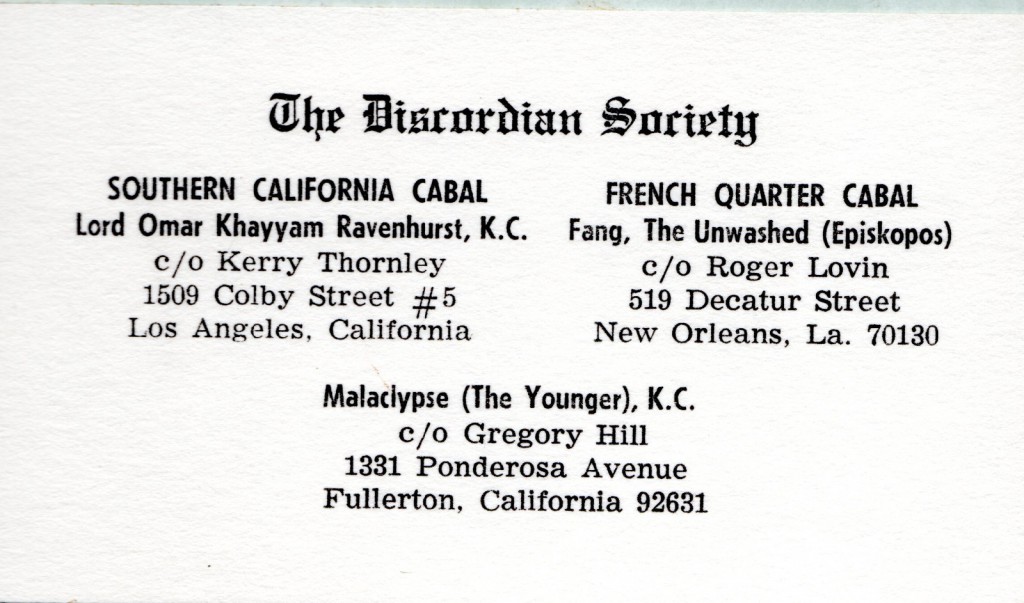
Kerry wasn’t just lightly tossing around the assertion that Lovin excommunicated new Discordian initiates, as revealed in this December 2, 1964 letter from Greg Hill (aka Malaclypse the Younger) to pilgrims Judy Gates and Bob Yeager.
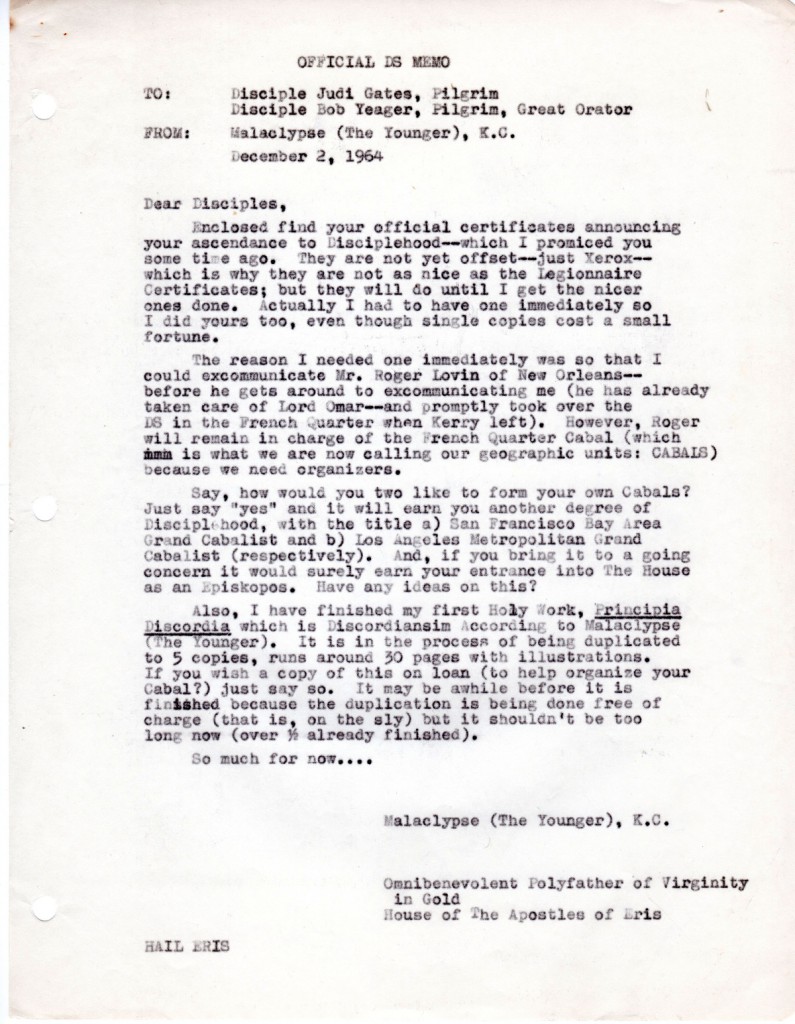
The Early Discordians become infamous for these types of humorous letters, and one of the funniest I’ve come across was composed by Lovin dated December 17, 1964, addressed to Greg Hill (who appears to have been staying with Bob Newport in Chicago at the time):
All Hail Discordia!!!!!?!!!!!!! To: MALACLYPSE (THE YOUNGER), K.C.: OMNIPOTENT POLYFATHER OF VIRGINITY IN GOLD AND HIGH PRIEST OF THE HERETIC FRINGE AND PROTESTANT PERSAUSION
FROM: FANG (THE UNWASHED), W.K.C.: LIBERATOR OF THE THIRD EYE, PROTECTOR of the WESTERN WORLD, EXALTED LAMA of the NEW ORLEANS CABAL, and L.L.L.L.L.L. (Lovin’s Licentiously Liberated Lightning Lechers)
Hail Eris,
Concerning thy recent epistle of Excommunication: Screw Thee. Thou wilt understand, of course, that it isn’t the humble Fang; but FANG, W.K.C.: L.T.E., P.W.W., E.L.N.O.C., and L.L.L.L.L.L. and wilt therefore realize that naught of a personal nature is meant… dig?
Wouldst do me the favor of communicating Lord Omar’s current whereabouts to me in the swiftest mode. This One is plagued with constant uncertainties and apprehensions due to an extreme dearth of information concerning That One. I fear me ever that the Foul Forces of Light and Reason have fallen upon him unaware and smotten (wow!) Him severely about the shoulders and intellect. Thou wouldst earn thyself everlasting gratitude and a mention in the evening maledictions by such an action. Also; if you don’t, I’ll kill you.
As to the progress of the New Orleans Cabal: The first Temple of Eris in New Orleans was formally defecated on Nov. 3, 1964, at 519 Decatur St. (which, oddly enough, is also my home address.) It occupied a converted broom closet. Admittedly, that is rather humble quarters for such a large and far-flung organization; but in the short space of one month we have more than doubled our area. This noble word was accomplished chiefly through the untiring efforts of our noble leader, FANG, W.K.C.: L.T.E., P.W.W., E.L.N.O.C., and L.L.L.L.L.L. and his noble assistant, Charles Noble. They single-handedly (one hand, three hooks) formed K.R.U.D. (Kollectors of Revenue Under Duress) and saw to the raising of funds. Our membership already includes two beatniks, one wasp, a hunchbrain, and a genuine, card carrying square who has 2.7 kids and a wife with a cloth coat. Therefore, be of good cheer. Today New Orleans, tomorrow the Catacombs – with some scattered showers in the evening.
As I am naturally curious about what sort of person would spend his time on such drivel as this, kindly send me some data about yourself. Send also a copy of HYMN. Barring the feasibility of a picture, send a piece of fingernail and some hair…..
In closing, let me say: MARY CHRISTMAS, SAVIOR MONEY!!!
(signed) FANG
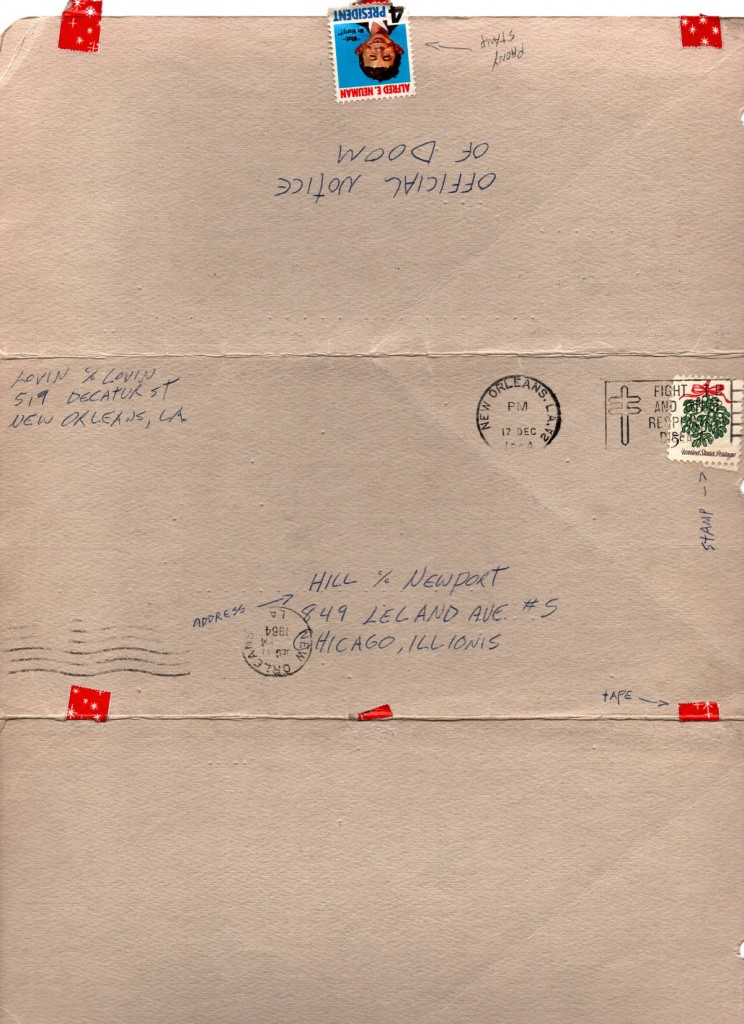
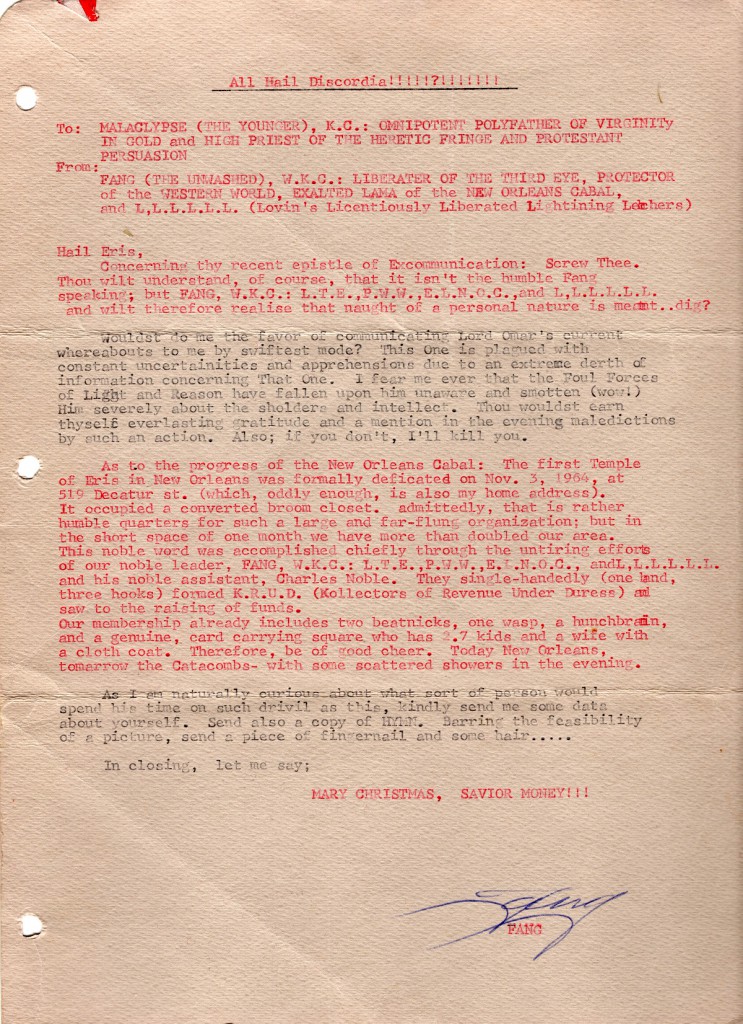
As the beatniks morphed into hippies, Lovin went right along for the ride. On December 9, 1966, he hosted a “psychedelic happening” billed as an “LSD trip without LSD” that certainly sounded Discordian in nature, as documented in the December 10, 1966 States Time Advocate news article below.
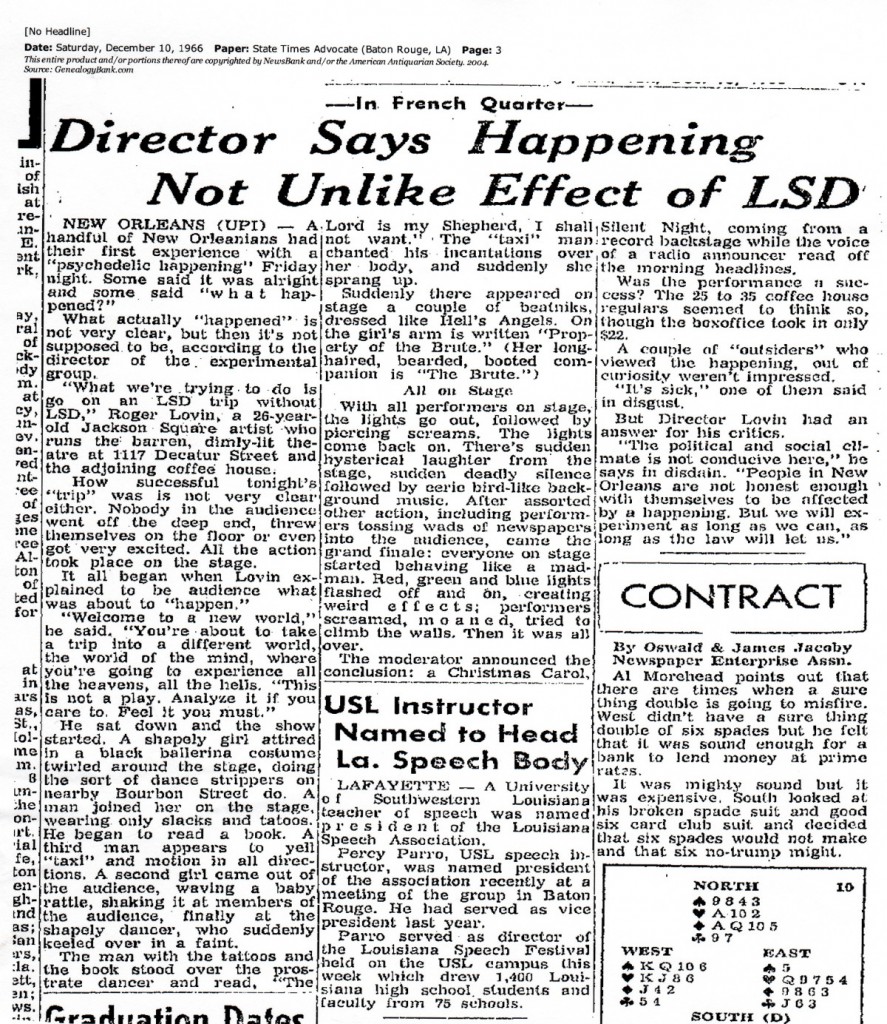
On October 16, 1968, Lovin appeared on TV program called Hotseat revealing “The Truth About Hippies.” It was around this time that he started the first underground newspaper in New Orleans, The Word (later to be known as The Ungarbled Word.) While all of this was going on, Lovin became a suspect of sorts in the Garrison investigation, all of which will be discussed in more detail than you can possibly imagine in future installment of this series!

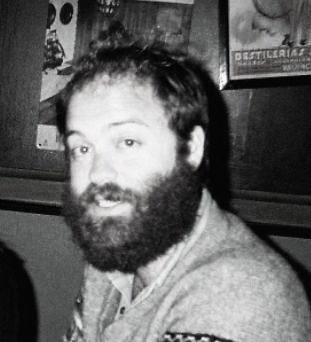
The essay includes references to my books and this website:
“Through his blog, Historia Discordia, Gorightly continues to transform Discordianism’s material culture into a historical narrative of its past. Thanks to the participatory nature of the Internet, Gorightly’s narrative concerning Discordianism’s historical development has attracted a number of online collaborators. While the intermingling of older Discordians with new converts is not, ostensibly, the primary purpose of the blog, it is inseparable from the archive’s aim of creating a serialized history of Discordianism…”
As Greer notes, this website would not be possible without online collaboration, and so thanks to everyone who has assisted along the way, most particularly Groucho Gandhi, K.S.P., who maintains and is the brains behind the site.
Since some might have trouble accessing the link if they aren’t already signed up at academia.edu, Christian green-lighted reposting a PDF of his essay here, which originally appeared in Fiction, Invention and Hyper-reality From Popular Culture to Religion (Routledge Inform Series on Minority Religions and Spiritual Movements) by Carole M. Cusack and Pavol Kosná.